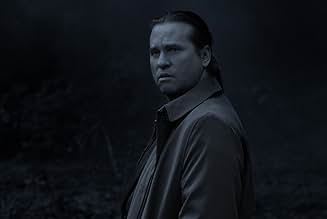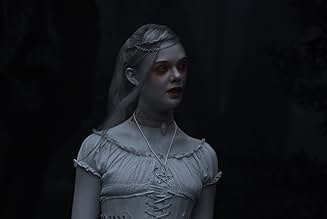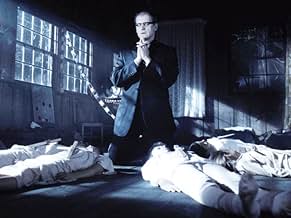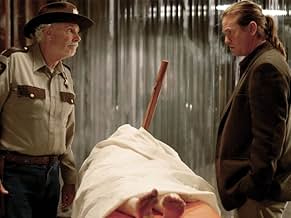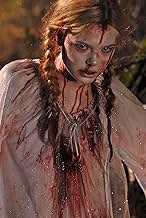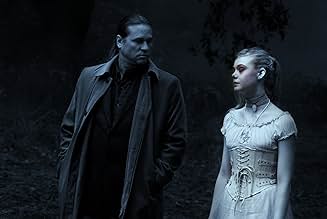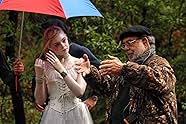Twixt
- 2011
- Tous publics
- 1h 20min
Découvrez la version authentique d'un meurtre-mystère envoûtant écrit, réalisé et produit par Francis Ford Coppola, avec Val Kilmer, Bruce Dern et Elle Fanning.Découvrez la version authentique d'un meurtre-mystère envoûtant écrit, réalisé et produit par Francis Ford Coppola, avec Val Kilmer, Bruce Dern et Elle Fanning.Découvrez la version authentique d'un meurtre-mystère envoûtant écrit, réalisé et produit par Francis Ford Coppola, avec Val Kilmer, Bruce Dern et Elle Fanning.
- Réalisation
- Scénario
- Casting principal
- Récompenses
- 2 nominations au total
Avis à la une
However, one of the reviews informs us this story came to Coppola in a dream while he was in Turkey. He has a reputation for being a bit of a doper and this dream must have been enabled by an overdose.
The plot is an absolute mess and makes any sense in only about 3 or 4 scenes. I am not someone who requires all loose ends be neatly tied up, but this story goes nowhere.
I don't see any way to pay much attention and enjoy the film. Perhaps if you get bombed, don't think about the story and just enjoy the view, it could be worth your time.
Coppola has said in interviews that he's only making "personal" films from now on - maybe too personal. While there are elements in this film that show the master has not lost his touch, this film borders on the incomprehensible. Is it a comedy? A horror film? A psychological drama? A fantasy? Your guess is as good as mine - and, apparently, the cast's, as three participants in the film in attendance said as much in the Q&A that followed the screening. Actors Bruce Miroglio, Anthony Fusco, and Don Novello all had the same reaction after screening the film (only their second opportunity.) First, it was nothing at all like the film they saw a few months ago and Coppola was obviously still tinkering with it. Second, it was a helluva lot funnier than they remembered it.
Confusion maybe the theme of the film, but should that confusion have extended to the cast and, ultimately, the audience? One of the things the audience was confused about was that it was a 3-D film. Everyone eagerly played with the glasses until an announcement was made that there were only two short sequences in 3-D, and that it would be clear when those times were. That still didn't stop people from flipping the glasses on and off in a futile attempt to add some dimension to the film.
Coppola's choice to use 3-D does say something, though. Consider his contemporary - Martin Scorsese. Scorsese embraced the technology, used it to great effect to enhance his storytelling in "Hugo," and foresees using the process for all of his future projects. (We'll see.) How does Coppola use it? As a gimmick. An effective gimmick, but a gimmick none the less. Scorsese used it to draw you into the world of "Hugo." Coppola's use actually, and purposely, takes you out of his. Interestingly, only one of the two sequences was filmed using a 3-D camera. The second was added in post-production.
It really wasn't necessary, as the look of the film is one of its assets. Visually entrancing, and wonderfully atmospheric, the film has a cinematic look unlike anything else Coppola has done - even "Dracula." As for the cast, Val Kilmer giver a lead performance that almost redeems him from the trainwreck that is "The Fourth Dimension." I could have done without his umpteenth Brando impersonation, though. Uniformly fine work from the supporting cast helps. It's always good to have Bruce Dern back on screen portraying one of his "slightly-off" characters.
The script is the film's Achilles Heel, if Coppola even had one. I don't need every element of a story to be spoon-fed to me, but give me something to chew on, please. "Twixt" leaves too many threads dangling from the seams that are obviously fraying in this film. The parts are all there, they're just waiting to be sewn together in a much better fashion. Its ending is abrupt and confusing. As Miroglio said when responding to an audience member's comment that he really didn't know what happened at the end, "Francis' response would probably be – 'GOOD!'" Maybe for him, but not for an audience. Coppola says he got the idea for the film from a dream of his. Coppola's turned his dream into an audience's nightmare. Does he even care?
www.worstshowontheweb.com
Hopefully B'Twixt will open this classic to a wider audience, I'm sure there are a lot of people who would appreciate this film, and give it the recognition it deserves.
I love the dreamy flow of the story. I can't think of anything that resembles B'Twixt, it's funny and spooky. The camera work and editing makes it an ethereal journey from beginning to end.
"B'Twixt Now and Sunrise" is Francis Ford Coppola's renamed reedit of his 2011 movie "Twixt," released in 2022. It's a mystery/dramedy with elements of horror, combining the look of Coppola's "Bram Stoker's Dracula" with the inscrutableness of his "Youth Without Youth," plus a welcome side of humor. It's a quirky mystery that leaves you scratching your head, but you find yourself enjoying the ride, a Gothic tale with beautifully haunting cinematography & atmosphere, highlighted by Poe, bell towers, ghosts and bats in the belfry. The enhanced moonlighting and otherworldly blueish gray tones are awesome.
It tackles the creative process as we observe the desperation of a writer scraping the bottom of the barrel, often under the influence of sundry intoxicants. Will he come up with a best seller? Will he solve the murder mystery? Will he come to terms with his specters and demons that arise from his guilt over what happened to his daughter? That element, by the way, brings to mind Francis' 23 years-old son, Gian-Carlo Coppola, who was tragically killed in a similar boating accident in May, 1986. The reckless driver was Griffin O'Neal (Ryan's son).
A lot of the movie is an internal dialogue with the author's own ghosts and literary influences. Charles Baudelaire (a notorious substance abuser) is referenced, with the aforementioned Poe intermittently appearing, but only when Baltimore is under the influence, or dreaming. Did the abuse and murder of the children happen as shown? Or did Poe and the vampire incarnation of Hall's own daughter serve as muses as he works his way through creating a story that might turn his career around? Coppola leaves it up to you to decide what is real and what is imagination, but the answers are there if you want 'em.
Francis got the story from a dream he had while staying in Istanbul. This sets-up the criticism that Coppola's dream is the audience's nightmare. While "Twixt" and this reedit are too ambiguous for their own good, it's obviously intentional and he wanted the viewer to leave with questions to ponder. Besides, does everything need to be spelled out?
As for comparing the two versions, this one's 8 minutes shorter and I think I liked it better (it's hard to say because I saw the former version 8 years earlier).
It was shot at Kelseyville and the Clear Lake area of Northern California.
GRADE: B+
Le saviez-vous
- AnecdotesDirector Francis Ford Coppola had originally intended the film as a type of "live editing" experiment using groundbreaking digital editing technology. Coppola intended to act as a sort of conductor during every screening of the film, lengthening or shortening scenes and even changing plot elements depending on the audience response. This caused long delays in the film's release and ultimately proved impractical, forcing Coppola to do a locked edit of the film, integrating elements from all various permutations of the story.
- GaffesWhen Hall Baltimore first goes to the hotel in the dream he orders just a beer. The beer is set in front of him and has a large head of foam. In the next scene the foam is gone. When the scene resumes the foam is back.
- Citations
[first lines]
Narrator: There was, once upon a time, a town not far from a big city. A road ran through, but there were only a few businesses. A coffee shop, a hardware store, a sheriff's office. And all kinds of people. Vagrants, run away teens, religious fanatics, retired seniors who, well, it was a town of those who wanted to be left alone. And so they were.
- ConnexionsFeatured in Twixt: A Documentary (2013)
Meilleurs choix
- How long is Twixt?Alimenté par Alexa
Détails
- Date de sortie
- Pays d’origine
- Site officiel
- Langue
- Aussi connu sous le nom de
- Twixt Now and Sunrise
- Lieux de tournage
- Aetna Springs, Pope Valley, Californie, États-Unis(Chickering hotel)
- Société de production
- Voir plus de crédits d'entreprise sur IMDbPro
Box-office
- Budget
- 7 000 000 $US (estimé)
- Montant brut aux États-Unis et au Canada
- 1 996 $US
- Week-end de sortie aux États-Unis et au Canada
- 1 996 $US
- 2 oct. 2022
- Montant brut mondial
- 649 835 $US
- Durée1 heure 20 minutes
- Couleur
- Rapport de forme
- 1.85 : 1
Contribuer à cette page








